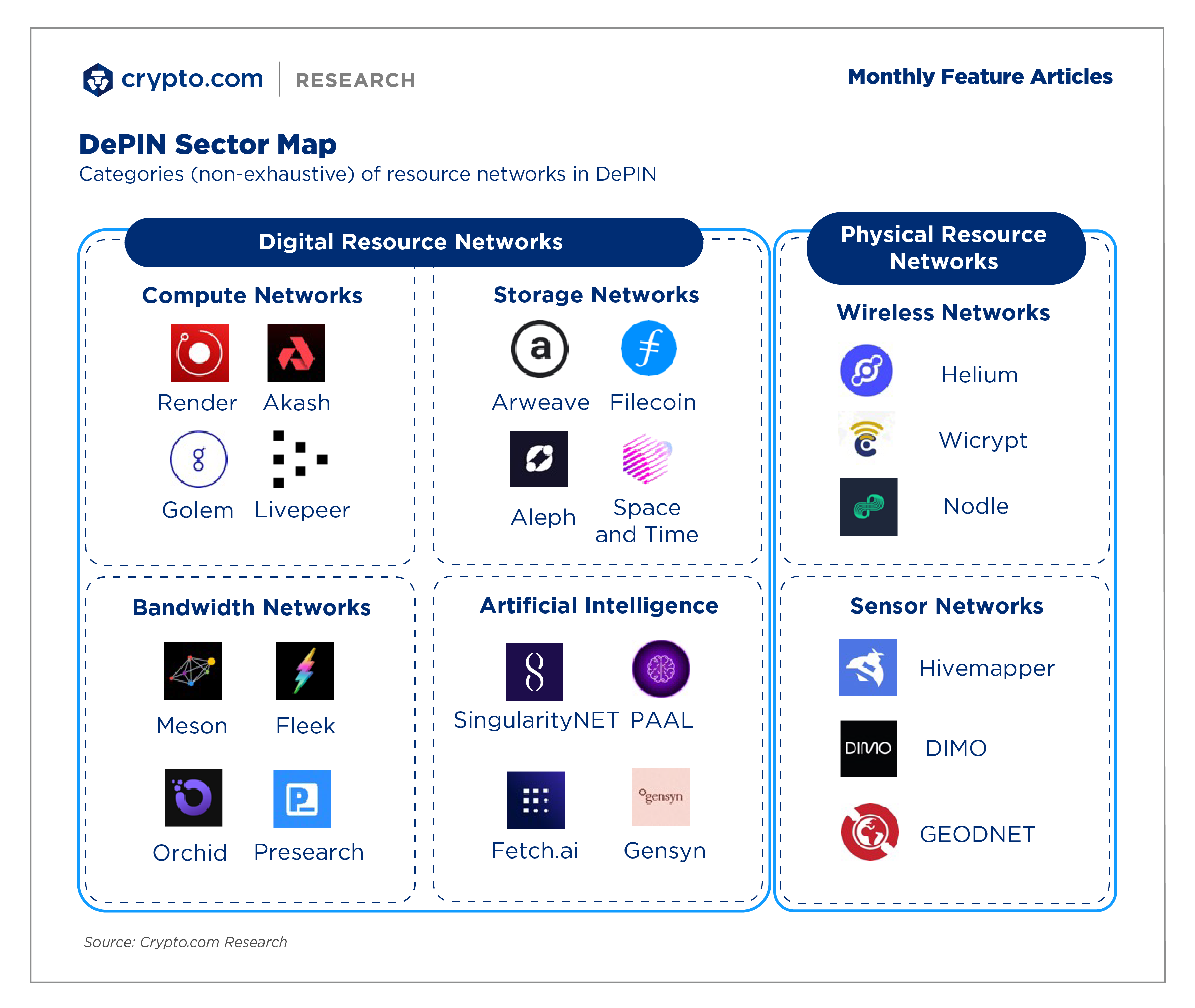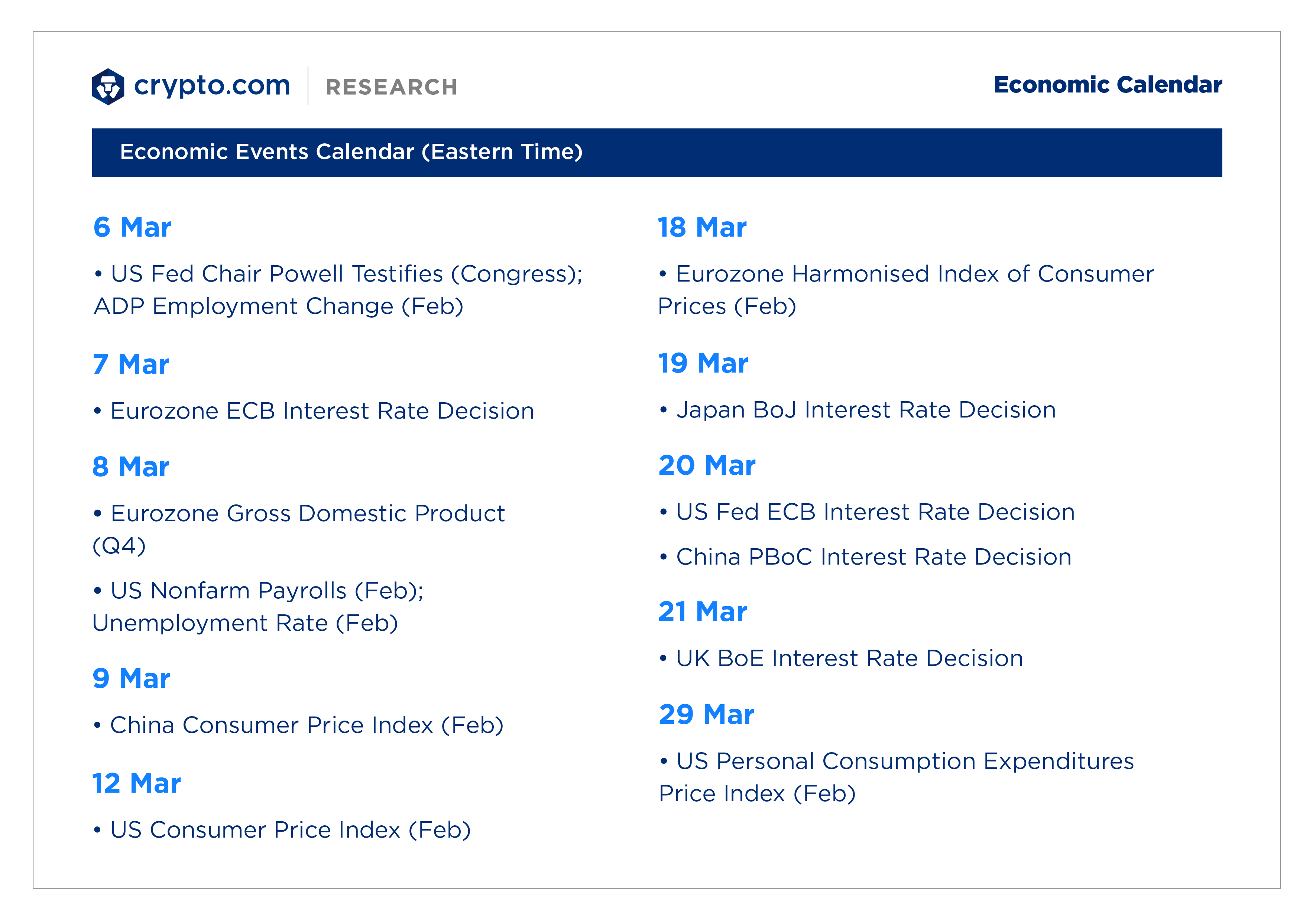
Welcome to the Crypto.com Monthly Research Roundup Newsletter!

1. Market Index
The monthly price and volume indices were positive at +44.54% and +1.51%, respectively, while the volatility index was negative at -9.77%.

2. Charts of the Month
Bitcoin continues to extend its gains and is currently above US$1 trillion in market cap for the first time since 2021. With over US$1 trillion in market cap, Bitcoin makes it into the trillion dollar club within a list of the top ten companies by market cap, joining the likes of Microsoft and Apple.

EigenLayer, an Ethereum-based liquid restaking protocol, saw a significant surge in its total value locked (TVL) hours after temporarily removing its staking cap. On 5 February, the protocol announced that it would lift the per-protocol staking cap of 200,000 ETH until 9 February to “invite organic demand” to the network. The protocol’s TVL saw a US$3 billion (121%) increase during this period, jumping from $2.5 billion on 5 February to about $5.57 billion on 9 February.
EigenLayer is pioneering restaking, allowing users to simultaneously earn Ethereum staking rewards while securing Actively Validated Services (AVSs) to generate additional yield. It introduced the caps last year to ensure security and decentralisation, mainly as a way to prevent any single token from dominating the network.

Blast, a Layer-2 blockchain developed by the team behind NFT marketplace Blur, launched its mainnet on 29 February. Following the launch, which allowed the unlocking of billions of staked cryptocurrencies, approximately 180,000 Blast users withdrew an initial amount of US$400 million from the network. As of 5 March, its TVL has surpassed $2.60 billion.
Blast stands out as an Ethereum Layer-2 solution that offers native yields for ETH and stablecoins to its users.

3. Special Research Articles

Restaking allows native staked ETH and liquid staking tokens (LST) to be staked with validators in other networks. Users utilise restaking to secure not only Ethereum but other networks or protocols and earn extra rewards by putting their staked ETH at risk for additional slashing conditions.
EigenLayer is the pioneer in restaking, aiming to solve the issues of fragmented trust networks by enabling users who have locked their ETH in staking to ‘restake’ it in separate smart contracts. Restaking has led to the development of liquid restaking, which recently gained significant traction.
Read more about the growing ecosystem of projects using EigenLayer and market overview of liquid restaking protocols from our latest report.


The year 2024 is welcomed with fresh developments and new milestones in the AI industry. A few key events are fueling the AI boom, such as OpenAI’s Sora launch and NVIDIA’s stellar earnings report. This has contributed to the resurging optimism in the wider AI space, subsequently trickling down to the crypto AI sector: The market capitalisation of AI-related tokens surpassed US$10 billion and surged by 74% year-to-date.
With the resurging AI and crypto narrative, we explore the AI token market through the lens of emerging decentralised AI solutions — mainly within the decentralised compute marketplace, AI Agent, and zero-knowledge machine learning (zkML) segments — in our latest report.

4. Monthly Feature Articles

Monthly Feature Article | DePIN: Crypto’s Rising Narrative
Decentralised physical infrastructure networks, also known as DePIN, provide a novel approach to developing real-world infrastructure via blockchain technology and tokenised economic incentives. It does this by leveraging unused global resources through open participation. The DePIN sector exists to enable the distributed and transparent provisioning of essential resources and services at a lower cost compared to centralised solutions. Real-world use cases range from file storage and computing to wireless networking and much more.
Although it has already been here for years, DePIN is becoming one of the rising narratives in the cryptocurrency industry. This report serves as an introduction to DePIN, sharing insights on how it works, its economic model, key trends in the space, the challenges and risks associated with the sector, and more.
Key takeaways:
- DePINs provide a novel approach to developing real-world infrastructure through blockchain technology and tokenised economic incentives that leverage unused resources worldwide through open participation.
- Major categories of DePIN projects include physical networks (location-based resources like sensors, and wireless) and digital networks (e.g., computing, and data storage).
- The rapid development of artificial intelligence (AI) is a key driver of DePIN being seen as a rising narrative in crypto.
- DePINs incentivise individuals and organisations to contribute excess infrastructure capacity through native tokens. If and when the network scales up through increased participation, the native tokens are expected to gain greater value. This boosts the rewards earned by resource providers, as well as the returns expected by investors.
- While DePINs show promise, challenges remain around price volatility, user awareness, and long-term infrastructure maintenance as these networks grow.

Monthly Feature Article | DePIN Landscape
The current DePIN landscape is vast and rapidly expanding — thanks to its real-world utility and innovations. The digital asset market cap in DePIN has surpassed US$25 billion as of writing, and the rapid growth in each category signals a positive outlook for the industry. Additionally, AI is also becoming a prominent sub-sector in DePIN, boosted by recent industry and technological developments.
In our latest private report, we share detailed insights from the overall DePIN landscape and dive deeper into each category, including DePIN projects covering AI, computing, wireless, sensor, and storage networks. We also look closer at the market status and key players from each segment, and provide an outlook for what lies ahead for DePIN.
Key takeaways:
- Decentralised Physical Infrastructure Networks (DePINs) provide a novel approach to developing and maintaining real-world infrastructure through the use of blockchain technology and tokenised economic incentives.
- The digital asset market cap in DePIN has surpassed US$25 billion. Chain-wise, most projects are built on Ethereum; however, other blockchains like Solana and DePIN-specific platforms like IoTeX are also gaining traction.
- Generally, DePIN projects can be categorised into physical networks (sectors including sensor and wireless) and digital networks (sectors including computing, data storage, bandwidth and AI).
- Of all sectors, the decentralised compute network had the largest market cap with about US$10 billion and over 250 projects.
- The developing AI space serves as a key growth driver for DePIN, allowing for decentralised AI and compute network categories to further develop and expand.
- Prices for storage solutions like Storj range from 70% to 99% cheaper than Amazon S3, while Sia and Filecoin achieve lower costs by leveraging an open marketplace model where the price of storage is a function of supply and demand cycles.
- Hivemapper is one of the projects that represents the growth and scale in the decentralised sensor category, with nearly 8 million unique kilometres globally mapped since it launched in November 2022 (to compare, it took 12 years for Google Maps to map 16 million kilometres).
- Decentralised wireless networks intend to address the growing demand for global wireless connectivity. In this sector, the related digital assets’ market cap was around US$2 billion.
- The rapid growth in each category signals a positive outlook for the industry and aims to solve pain points within the Web2 space. Looking ahead, we can expect greater synergies amongst categories, exponential growth within the decentralised AI category, and other integrations within crypto-native primitives.

Interested to know more? Access exclusive reports by signing up as a Private member, joining our Crypto.com Exchange VIP Programme, or collecting a Loaded Lions NFT.
5. Alpha Navigator
This institutional-focused report dives into macro trends, market-neutral pairs, style-factor screens, and events. Read the full Alpha Navigator report here.
- Asset classes were mixed in February, with crypto outperforming significantly.

- BTC correlations with equities were positive in the past 1-month.

6. Crypto Conference & Economic Calendar from Market Pulse
Crypto Conferences Calendar

Economic Calendar

Looking for more? Check out our most recent reports and trending market updates:
Get fresh market updates delivered straight to your inbox:
Thank you for supporting Crypto.com
Best regards,
Research & Insights Team




